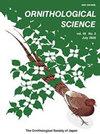日本北海道Fukagawa群上新世Alcidae的一个Humerus化石(Aves:Charadriformes)
IF 0.3
4区 生物学
Q4 ORNITHOLOGY
引用次数: 0
摘要
摘要海雀科(Alcidae, auks)是一种翼推进潜水的船形目,共有24种,分布在全北极地区。本文描述了一具来自日本北海道深川群的上新世Alcidae(约4.5-3.5 Ma)肱骨化石。虽然该标本不完整,缺乏特异属的诊断特征,但它与Uria具有相似的特征,如大小,背侧压缩的肱骨干,低而光滑的三角胸肌嵴,以及近矩形的喙上瘢痕。虽然在东太平洋(即墨西哥和美国加利福尼亚)中新世-更新世(23.0-0.0117 Ma)沉积物中发现了一些Alcidae化石,但对西太平洋(即亚洲)的化石知之甚少,大多数化石来自更新世(约0.7-0.12 Ma)沉积物。本研究报道了西太平洋上新世第一个Alcidae,表明Alcidae早在上新世就已经分布在全北极地区。本文章由计算机程序翻译,如有差异,请以英文原文为准。
A Fossil Humerus of Pliocene Alcidae (Aves: Charadriiformes) from the Fukagawa Group in Hokkaido, Japan
Abstract Alcidae (auks) is a family of wing-propelled diving Charadriiformes, which includes 24 extant species distributed in the Holarctic region. Here, we describe a fossil humerus of Pliocene Alcidae (approximately 4.5–3.5 Ma) from the Fukagawa Group in Hokkaido, Japan. Although this specimen is incomplete and the diagnostic characters of the specific genus are lacking, it shares similar characteristics with Uria, such as the size, dorsoventrally compressed humeral shaft, low and smooth crista deltopectoralis, and a nearly rectangular supracoracoideus scar. While several Alcidae fossils have been reported from the Miocene–Pleistocene deposits (23.0–0.0117 Ma) of the Eastern Pacific (i.e., Mexico and California, USA), little is known about fossils from the Western Pacific (i.e., Asia), most of which have been found from Pleistocene deposits (approximately 0.7–0.12 Ma). This study, reporting the first Pliocene Alcidae from the Western Pacific, implies that the Alcidae were already distributed in the Holarctic region during the early Pliocene.
求助全文
通过发布文献求助,成功后即可免费获取论文全文。
去求助
来源期刊

Ornithological Science
ORNITHOLOGY-
CiteScore
1.20
自引率
0.00%
发文量
26
审稿时长
>12 weeks
期刊介绍:
Ornithological Science publishes reviews, original articles, short communications and comments covering all aspects of ornithology. Manuscripts are judged on the basis of their contribution of original data and ideas or interpretation. All articles are peer-reviewed by at least two researchers expert in the field of the submitted paper. Manuscript are edited where necessary for clarify and economy. Ornithological Science aims to publish as rapidly as is consistent with the requirements of peer-review and normal publishing constraints.
 求助内容:
求助内容: 应助结果提醒方式:
应助结果提醒方式:


